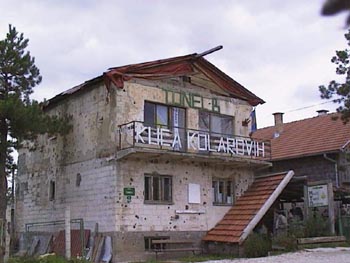A nice trip is to visit the tunnel under the airport, which kept the town alive for several years. This tunnel, dug by the Bosnian army in 1992, is 800 meters long. It took 4 months and 4 days to dig it and it became the main artery of Sarajevo.
On the other side of the airport you would come in some flat fields, from where you could get to Mount Igman, the only mountain not occupied by Serb forces. When you crossed that mountain you would come in a greater area in central Bosnia, from which you could go to Croatia.
The little tunnel museum is in a house on the other side of the airport, near the former front lines and the SFOR camp. The house was (and is) the house of the Kolarov family. They try to maintain the history of their lives and their country by running this little museum. They also try to make a living out of it. Strangely enough, the local authorities have not shown any interest in these peoples' situation since the war ended. While many high-positioned internationals visit the place and let themselves be informed extendedly, the Federation's minister of culture spoke about a tunnel of at least 100 meters, so it became obvious she was completely not aware of the reality of that place (and of history).
Through this tunnel weapons, ammunition, food, telephone lines, wounded people and even dead people entered the town. Even the president had to use the tunnel sometimes if he was to meet others outside of town. In that case he could sit in a chair that was pushed on a rail.
You can see all the materials that went through the tunnel, and you can see a video in which the bitter reality of war is shown once again. You can also hear many anecdotes.
Last time I was there I heard one that I found shocking. What happened: In Sarajevo there were many people but not enough weapons or ammunition. On the Serb side the situation was exactly the opposite -- not enough people but plenty of weapons. Therefore, exchanges took place. It happened that citizens of Sarajevo, Serbs among others, refused to join the army and go to the trenches. Many of these people were arrested and held. These kind of prisoners, who were mostly Serbs, were traded for weapons and ammunition. So the prisoners did not end up in the trenches of their city, but on the other side of the front line, where they were shot at with the bullets that were part of their ransom.
The Sarajevo War Tunnel is open everyday from 10.00 till 16.00 hours. The entrance is free but it is normal to pay 5 DM. A visit, including watching the video, will take about an hour and a half. You can find the museum by going to the military camp Butmir through Ilidza. Just before the camp there is a sign to the left.
In case you come from the other side (through Serb Sarajevo on the outskirts of town), you pass CD alley, a street with 30 CD shops with extremely cheap CDs, but you cannot enter the tunnel from that side because of the little village (the Butmir camp) there.

 l
l